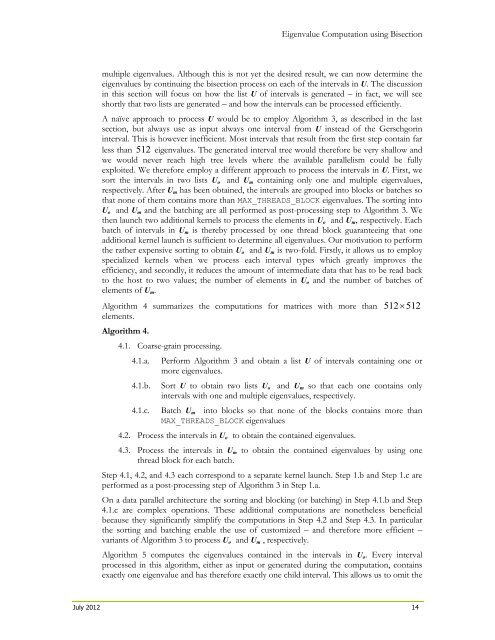Christian Lessig
SORtc
SORtc
- No tags were found...
You also want an ePaper? Increase the reach of your titles
YUMPU automatically turns print PDFs into web optimized ePapers that Google loves.
Eigenvalue Computation using Bisection<br />
multiple eigenvalues. Although this is not yet the desired result, we can now determine the<br />
eigenvalues by continuing the bisection process on each of the intervals in U. The discussion<br />
in this section will focus on how the list U of intervals is generated – in fact, we will see<br />
shortly that two lists are generated – and how the intervals can be processed efficiently.<br />
A naïve approach to process U would be to employ Algorithm 3, as described in the last<br />
section, but always use as input always one interval from U instead of the Gerschgorin<br />
interval. This is however inefficient. Most intervals that result from the first step contain far<br />
less than 512 eigenvalues. The generated interval tree would therefore be very shallow and<br />
we would never reach high tree levels where the available parallelism could be fully<br />
exploited. We therefore employ a different approach to process the intervals in U. First, we<br />
sort the intervals in two lists U o and U m containing only one and multiple eigenvalues,<br />
respectively. After U m has been obtained, the intervals are grouped into blocks or batches so<br />
that none of them contains more than MAX_THREADS_BLOCK eigenvalues. The sorting into<br />
U o and U m and the batching are all performed as post-processing step to Algorithm 3. We<br />
then launch two additional kernels to process the elements in U o and U m , respectively. Each<br />
batch of intervals in U m is thereby processed by one thread block guaranteeing that one<br />
additional kernel launch is sufficient to determine all eigenvalues. Our motivation to perform<br />
the rather expensive sorting to obtain U o and U m is two-fold. Firstly, it allows us to employ<br />
specialized kernels when we process each interval types which greatly improves the<br />
efficiency, and secondly, it reduces the amount of intermediate data that has to be read back<br />
to the host to two values; the number of elements in U o and the number of batches of<br />
elements of U m .<br />
Algorithm 4 summarizes the computations for matrices with more than 512 512<br />
elements.<br />
Algorithm 4.<br />
4.1. Coarse-grain processing.<br />
4.1.a.<br />
4.1.b.<br />
4.1.c.<br />
Perform Algorithm 3 and obtain a list U of intervals containing one or<br />
more eigenvalues.<br />
Sort U to obtain two lists U o and U m so that each one contains only<br />
intervals with one and multiple eigenvalues, respectively.<br />
Batch U m into blocks so that none of the blocks contains more than<br />
MAX_THREADS_BLOCK eigenvalues<br />
4.2. Process the intervals in U o to obtain the contained eigenvalues.<br />
4.3. Process the intervals in U m to obtain the contained eigenvalues by using one<br />
thread block for each batch.<br />
Step 4.1, 4.2, and 4.3 each correspond to a separate kernel launch. Step 1.b and Step 1.c are<br />
performed as a post-processing step of Algorithm 3 in Step 1.a.<br />
On a data parallel architecture the sorting and blocking (or batching) in Step 4.1.b and Step<br />
4.1.c are complex operations. These additional computations are nonetheless beneficial<br />
because they significantly simplify the computations in Step 4.2 and Step 4.3. In particular<br />
the sorting and batching enable the use of customized – and therefore more efficient –<br />
variants of Algorithm 3 to process U o and U m , respectively.<br />
Algorithm 5 computes the eigenvalues contained in the intervals in U o . Every interval<br />
processed in this algorithm, either as input or generated during the computation, contains<br />
exactly one eigenvalue and has therefore exactly one child interval. This allows us to omit the<br />
July 2012 14


